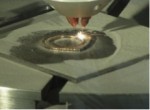06/7/12: by Bill Anderson
The National Network for Manufacturing Innovation
Take a drive through any industrial city across the United States. Take a good look at the shuttered factories behind locked gates that not so long ago manufactured quality televisions, clothing, shoes, automobiles and, quite importantly, critical military equipment to support our men and women in uniform.
Beyond the important products produced at these now abandoned facilities, contemplate for a moment the countless young people who went off to college from these communities, with tuitions paid from the healthy wages earned by parents working in highly skilled blue collar trades. Those highly skilled labor positions served as a vital stepping-stone on the path to upward mobility for anyone willing to work hard.
Laser Additive Manufacturing Machine
Credit: The Connecticut Center for Advanced Technology, Inc., East Hartford, CT
Now, think about the national security implications of the manufacturing capability this country had at the end of the Second World War.

There was nothing this country could not produce…so the United States was not reliant on others to feed and clothe its people, power its cities or to defend itself. Regrettably, the same cannot be said today. The pursuit of cheap labor, readily available within emerging economies throughout the world, swept entire industries away from our shores…and the skill sets to do these high value manufacturing activities went with them. Make no mistake…vibrant and open global trade is good for all.
However, national security and continued economic prosperity for the United States requires the maintenance and nurturing of highly skilled manufacturing capabilities here at home, as well as control of the supply chain that supports the end to end manufacturing process.
Fifty years ago, understanding and managing the supply chain was relatively easy, as it largely began and ended within our borders.
Today, it’s not that simple. Products are more complicated, requiring more exotic materials…sourced from all corners of the earth.
The supply chain is truly global…with material and components sourced from countless vendors around the world. Ask a sourcing manager at any major industrial company. He or she will be hard pressed to identify the source of a material or subcomponent more than two levels deep in the supply chain.
So, do we really understand the implications of a commercial disruption to the global supply chain on the ability to deliver goods and services as required? How about our ability to thoroughly understand how global conflict would impact that complex supply chain?
The plain fact is that if we are honest with ourselves, we have no way to fully analyze these risks…they are way too far flung.
A good deal of effort is expended within DoD to manage critical components in the military supply chain.
But, what are critical components?
We’re usually talking about high tech parts or mission critical items. But, make no mistake, a simple nut and bolt becomes critical if during wartime that nut and bolt is provided by a supplier nation that is now our adversary and there is no local source of supply.
Do we really have the visibility and capability of controlling the end-to-end military supply chain to ensure our warfighters can do the mission in the event of a global conflict?
Unfortunately, the answer today is “no”.

The risk inherent in the U.S. military industrial supply chain is unacceptable at present…and swift action is warranted to begin righting the ship.
So, what do we do to begin the important work of re-establishing America’s industrial base?
On March 9th, 2012, President Obama took a major step in the right direction by announcing his vision for the National Network for Manufacturing Innovation (NNMI). The goal is to put into place up to fifteen Institutes for Manufacturing Innovation spread across the country…serving as regional hubs for manufacturing excellence.
This collaboration between the Departments of Defense, Energy and Commerce is intended to increase the competitive manufacturing environment in the U.S., thus encouraging investment here at home in this crucial business sector.
A bold plan…intended to drive collaboration between businesses of all sizes, not-for-profit organizations, academia and governments at the Federal, state and local level.
A sharing of financial risk is expected…with a portion of the funding coming from a substantial government contribution, but with an expectation of cost sharing from other sources, including the private sector.
The major focus areas are to include (1) technology innovation, (2) moving from innovation to commercialization, and (3) training the workers of the future, via workforce development, to provide skills necessary to compete in the high tech manufacturing environment.
The President proposes to kick off his bold agenda in 2012 with the creation of a Pilot Institute, funded in part with $30 million of Federal dollars, mostly from DoD. The focus of the Pilot Institute will be additive manufacturing…identified as being of strong interest to the DoD, especially the Air Force.
Significant relevance in the commercial sector was also identified as a compelling reason to focus on additive manufacturing in the pilot program. Additive manufacturing draws upon three dimensional model data and utilizes lasers and other equipment to build parts up layer-by-layer, rather than the traditional methods of “subtractive technologies”.
The approach promises reduced costs and waste in the production process, while rapidly increasing the speed of manufacture. Additive manufacturing represents a significant leap forward in providing access to obsolete parts no longer in production. As our military weapon systems continue to age in this budget-constrained world, a low cost and readily available supply of parts for old equipment from reliable local sources will be absolutely critical.
Though a $30 million price tag for the Federal contribution to the pilot seems pretty modest in the context of the overall U.S. military budget, there are very clear ways to reduce costs dramatically.
$15 million has been budgeted to invest in advanced manufacturing equipment for the pilot…with another $5 million allocated to support advanced manufacturing research. What if I told you that the equipment already is in place and operational…and that significant research has already been completed…all that could adequately support the Pilot Initiative without spending another dime of taxpayer money on new equipment or facilities?
Though there are likely a number of examples of where equipment and knowhow already exist…let me draw your attention to just one.
In 2005, the Air Force funded the National Aerospace Leadership Initiative (NALI)…its charter is to promote innovation and integration of new manufacturing technologies throughout the aerospace industry.
You will note that NALI’s charter is spot on with the directives given to NNMI by the President.
In addition, the NALI consortium has invested in advanced manufacturing equipment and capabilities and is already using the technology to produce aerospace parts utilizing additive manufacturing processes.
NALI has, in addition, established a world-class workforce development capability focused on manufacturing and the aerospace industry…also required of the Pilot Institute…ready to go with no ramp up. The capabilities of NALI (and other operations already in existence around the country similar to NALI) could immediately be tasked to execute the requirements assigned to the Pilot Institute…saving money and accelerating progress.
Sounds like a win-win to me.
And how far can we stretch additive manufacturing capabilities to meet warfighter requirements?
Well…it seems now that those capabilities can be taken right into the operating room. The same processes used to fabricate replacement parts for military equipment appear equally as adept in mapping and building reproductions of human bone…saving or reconstructing the lives of our warrior heroes. No doubt we have yet to scratch the surface of where additive manufacturing can take us.
So…kudos to the Obama administration for moving us aggressively along a very important path.
Let’s just hope that those tasked with execution of the strategy show prudent stewardship of taxpayer dollars by fully exploiting the equipment, knowhow and trained personnel already in place and paid for with our tax dollars to both economically and expeditiously move us towards success in this critical initiative.
The Honorable William C. (“Bill”) Anderson served as Assistant Secretary of the Air Force for Installations, Environment and Logistics and the Air Force Senior Energy Executive under President George W. Bush from 2005 to 2008. The author can be contacted at CO****@*****il.com.


